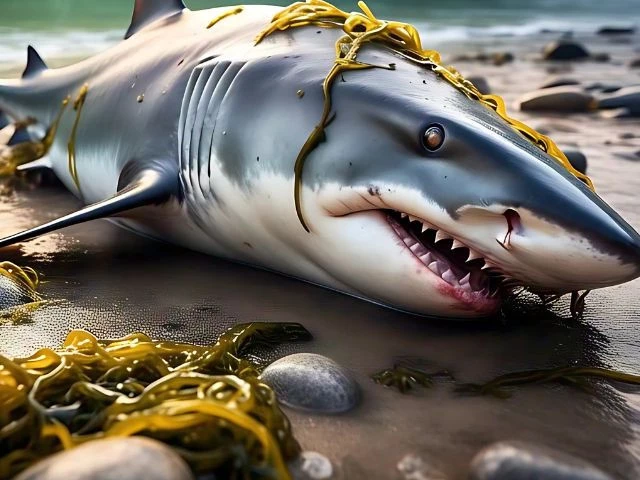Toxic algae kills fish, sharks, octopuses in South Australia: study
Unusual temperatures and calm seas are fueling a deadly underwater crisis.

A toxic algal bloom stretching along South Australia’s coastline since March has killed more than 200 marine species, including sharks, leafy sea dragons and octopuses, researchers said.
The bloom, caused by the harmful algae "Karenia mikimotoi", has acted like a “toxic blanket”, suffocating marine life, said Brad Martin, South Australian project manager at OzFish, a conservation group.
Analysis of more than 1,400 citizen scientist reports by OzFish found that 47% of the species killed were ray-finned fish, while 26% were sharks and rays.
Cephalopods such as squid, cuttlefish and octopuses accounted for 7% of the casualties, while decapods – including crabs, lobsters and prawns – made up a further 6%.
“This type of bloom creates a low-oxygen environment, and marine animals simply cannot escape it,” Martin said.
Karenia blooms are rare but deadly, releasing toxins and depleting oxygen levels in affected waters. Scientists say changing ocean conditions may be fuelling more frequent and severe outbreaks.
Coastal communities and fisheries have reported widespread beach strandings, with some species never before seen in such numbers in die-offs.
Local environmental groups have called for increased monitoring and long-term marine health strategies as ocean temperatures rise.
“It can choke fish by blocking their gills, trigger internal bleeding by damaging red blood cells, and act as a neurotoxin that disrupts the brain and nervous system, leading to erratic behaviour,” he said.
“That’s why some fish and sharks have been behaving abnormally, and why many of the dead animals appear reddish – it’s like a horror scene beneath the waves.”
South Australia’s environment department said the algal bloom is being fuelled by a prolonged marine heatwave, with sea temperatures around 2.5 degrees Celsius above average, combined with calm seas, low wind, and minimal swell.
Though not harmful to humans, the algae can trigger skin irritation and respiratory issues, and has led to widespread marine deaths.
First detected in mid-March off the Fleurieu Peninsula, the bloom has since spread to coastal areas across the state’s south-east, including the Gulf St Vincent, Yorke Peninsula and Kangaroo Island, according to OzFish’s Brad Martin.
OzFish, a group focused on restoring aquatic ecosystems, expressed concern over the long-term consequences for fisheries, as the bloom has affected fish of all life stages – from juveniles to mature, breeding adults – along with their natural prey.
South Australia’s environment minister, Susan Close, said several oyster farms and commercial pipi harvesting operations had been suspended due to the outbreak, calling it an unprecedented event for the state.
“This is a major algal bloom with serious effects on marine species,” she said, adding that in some areas, the bloom has penetrated as deep as 20 metres.
Professor Shauna Murray, a marine biologist at the University of Technology Sydney who identified the algae using microscopy and DNA analysis, said around 100 species of harmful algae are known globally, each with distinct toxic impact.
Although not yet fully understood, Karenia mikimotoi is believed to release a reactive form of oxygen that damages fish gill cells, effectively suffocating them, said Professor Shauna Murray.
The current bloom spans more than 150 kilometres along the coast, but it is not the largest recorded in Australia. In 2013, a different algal species, Alexandrium catenella, covered Tasmania’s entire east coast, halting aquaculture and seafood operations for nearly four months, Murray added.
Large-scale algal blooms can also reduce oxygen levels in the water, said Professor Martina Doblin, an oceanographer at the University of Technology Sydney who specialises in harmful algal events.
Karenia mikimotoi is unusual, Doblin explained, in that it can draw energy from both sunlight and feeding on other organisms.
This dual capability, combined with abnormally warm and stable ocean temperatures, has allowed the bloom to expand and persist over time.
“At low levels, it forms part of the natural food chain. But when it grows in large concentrations, it becomes a serious threat,” she said.
Though rare, such blooms can have serious consequences for local economies. Doblin said better early warning and response systems could help minimise the impact of future outbreaks.
A spokesperson for South Australia’s environment department said strong westerly winds are needed to disperse the algae.
However, the presence of ongoing high-pressure systems across southern Australia has delayed the arrival of those wind.




1728896365-0/marine-plants-file1725562192-0-(1)1728896365-0-100x90.webp)






















COMMENTS
Comments are moderated and generally will be posted if they are on-topic and not abusive.
For more information, please see our Comments FAQ